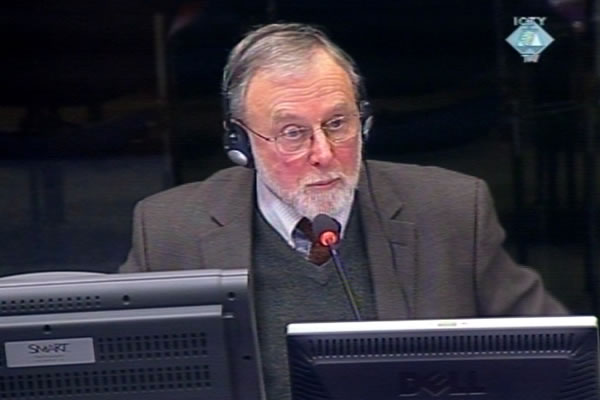Home
BADLY ELIMINATED TRACES OF CRIME
The examination-in chief of the former head of the Srebrenica investigation Jean-Rene Ruez was completed today. American forensic anthropologist William Haglund was called next. From 1996 to 1998, Haglund was involved in the exhumation of mass graves in Cerska, Orahovac and the Branjevo farm
 Jean-Rene Ruez, witness at the Radovan Karadzic trial
Jean-Rene Ruez, witness at the Radovan Karadzic trial Last week French inspector and former head of the OTP Srebrenica investigation team began his evidence at the trial of Radovan Karadzic. Today Ruez continued his testimony. The judges admitted into evidence an album containing 270 maps, aerial images and photos taken during the investigation of the events in the Srebrenica area in July 1995 after Mladic’s forces overran the enclave which was nominally under UN protection.
At the beginning of his testimony last Friday, Ruez described what happened in Srebrenica and Potocari on 11, 12 and 13 July 1995: separating men from the rest of the population and their detention in the white house, the deportation of the women and children, the ‘man hunt’ on the road from Bratunac to Konjevic Polje, the surrender of men from the column which was trying to break through to Tuzla, who were then gathered in a field near Sandici, the transfer of the captives to temporary detention facilities, the massacre in the warehouse in Kravica and in a field near Orahovac. Today, Ruez testified about other sites where men were detained, executed and buried in mass graves in the Srebrenica region: a site near the Petkovci dam, in Kozluk, at Branjevo farm and in the Culture Hall in Pilica.
The key issue was the ‘looting’ of primary graves at the sites and the transfer of the victims’ bodies to secondary graves to cover up the crime. In the first stage of the investigation in 1996, the remains of about 500 people were found at those locations. ‘It was evident’ that the primary graves had been ‘looted’ and that most of the bodies had been transferred to new locations, to the so-called secondary graves.
The first four secondary graves were located in the southern part of the enclave, in the Zeleni Jadar area. New discoveries followed. As the Office of the Prosecutor staff reviewed the aerial photos provided by the US administration, they noticed the substantial disturbances in the terrain configuration at the mass execution sites and the so-called primary graves. Backhoes and trucks are visible on some photos taken in September and October 1995 contained in Ruez’s album. The trucks were there to be loaded with bodies dug up from the primary graves. The photos also showed tire tracks left by the trucks that already left with their cargo. According to the witness statements, the victims’ bodies were transferred to a number of new sites, ‘scattered’ over a wide area to cover up the exact number of victims, should any of the mass graves be found.
Ruez’s evidence was interrupted after the examination-in chief in order for the prosecution to call American forensic anthropologist William Haglund, who served as senior forensic advisor in the OTP from 1996 to 1998. He headed the operation to exhume mass graves at several sites in the Srebrenica area. Dr. Haglund was also involved in the post mortems of the recovered remains. Dr. Haglund has testified at three Srebrenica trials and the transcript of his evidence at the trial of General Radislav Krstic was tendered into evidence at Radovan Karadzic’s trial.
Haglund’s expert reports on the exhumations of mass graves in Cerska, Orahovac and Branjevo farm were also admitted into evidence. The mass grave in the Cerska valley was 30 meters long and 6 meters wide. The remains of 150 men were recovered from the grave; 149 of them had gunshot wounds. The grave in a field near Orahovac named Lazete 2 consisted of two pits: one was intact, while the other had been exhumed or looted. A total of 112 ‘relatively intact bodies’ were recovered from the first pit. Fifty-two ‘incomplete bodies’ and 98 body parts were recovered from the second pit. Whoever had dug up the mass grave in order to eliminate the evidence of the crime didn’t ‘do a good job’, Dr. Haglund remarked.
About 1,000 Bosniaks were executed on 16 July 1995 at the Branjevo farm. A mass grave, 28 meters long, 5 meters wide and 5 meters deep, was found at the site. The bodies were found in a small part of the grave.Of the 138 victims whose remains were exhumed from the mass grave, 77 had their hands tied behind their backs. The rest of the bodies were removed in a secret operation to eliminate the evidence of the crime; they were buried in so-called secondary graves in remote locations.
Dr. Haglund will continue and complete his evidence tomorrow. Ruez, who worked for the OTP as an investigator, will be recalled to be cross-examined by the accused.
Photos
Linked Reports
- Case : Karadzic
- 2012-01-27 RECONSTRUCTING THE CRIMES IN SREBRENICA
- 2012-01-27 KARADZIC WANTS INTERVIEWS WITH GREEK PRESIDENT AND FRENCH OFFICER
- 2012-01-26 KARADZIC FALLS BACK ON SUNSHINE AND SHADOWS IN HIS DEFENSE
- 2012-01-31 KARADZIC: MASS GRAVES WERE THE RESULT OF TERRAIN CLEAR-UP
- 2012-02-01 RUEZ: ONLY ‘VICTIMS OF EXTERMINATION’ WERE BURIED IN MASS GRAVES
- 2012-02-02 KARADZIC COUNTS PRISONERS ON AERIAL PHOTOS

